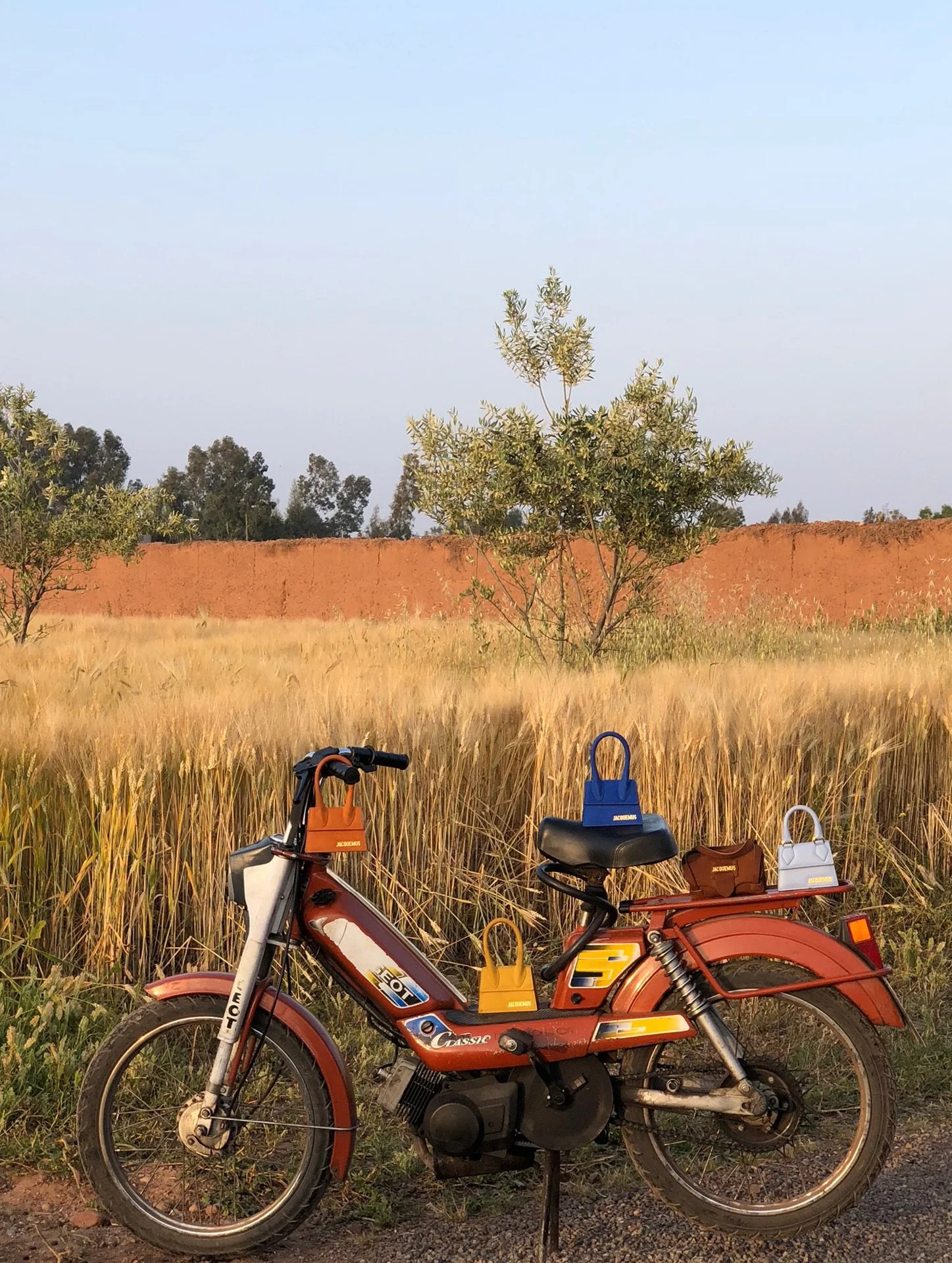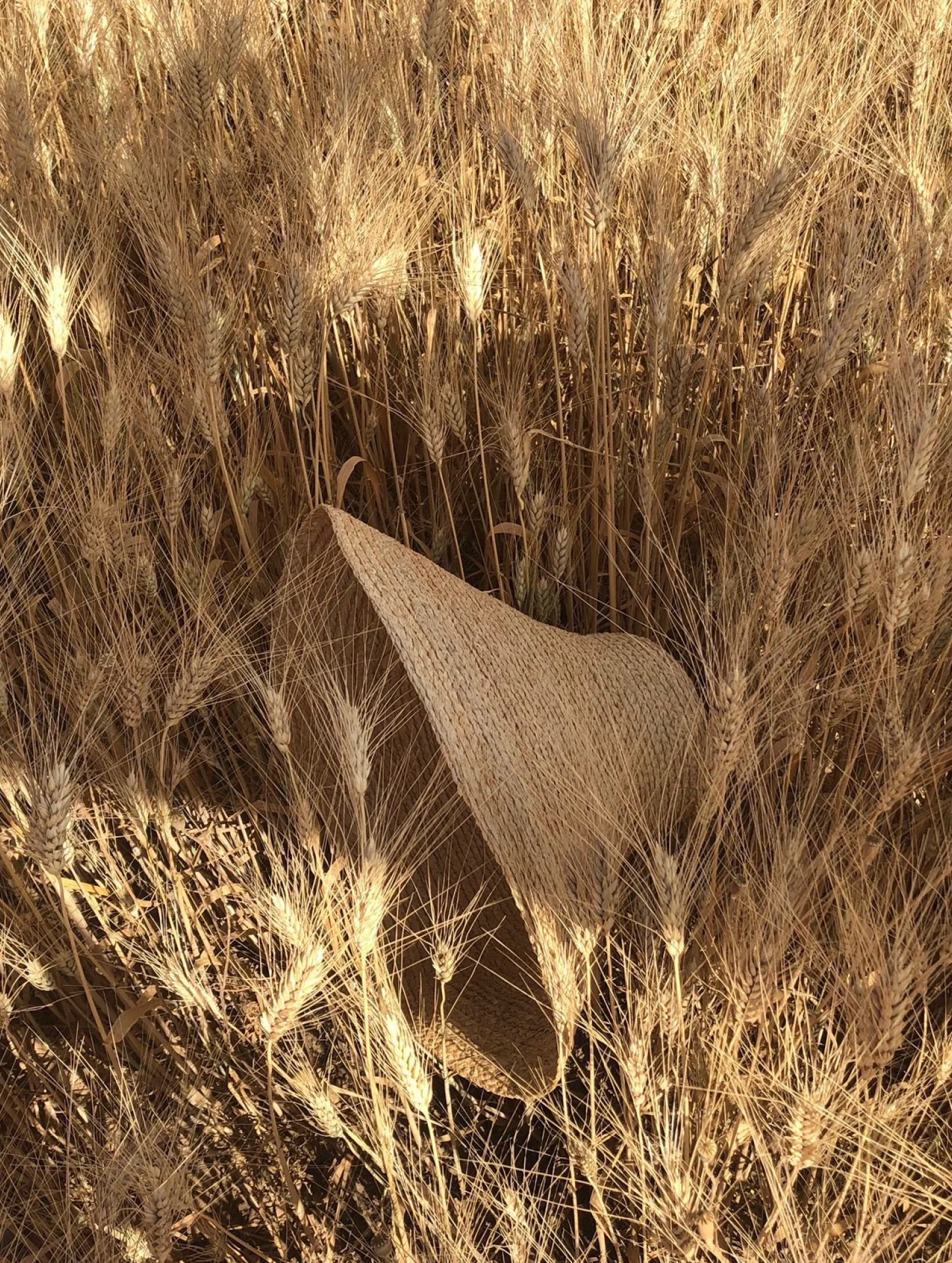POETRY OF LIFE
French designer Simon Porte Jacquemus tells a timeless story of pastoral beauty and simple pleasures, one image at a time.
By JON ROTH
Photography SIMON PORTE JACQUEMUS
The first time you came in contact with Jacquemus, it almost certainly happened on Instagram. Maybe you scrolled past a sun-struck country field, or a bowl of citrus, or a handsome, smiling man looking directly at the camera. Maybe you even saw a garment or accessory from the French fashion house – a very tiny bag, for example, or a wildly oversized hat. You may not have made the connection between the field of wheat or the bowl of lemons and the growing brand behind it, but the image likely spoke to you all the same, conjuring happy memories of warm places, and so in that first encounter, Simon Porte Jacquemus had already achieved his goal: to make you smile.
There is a formula of sorts to Instagram success, and it’s easy enough to learn: bright pops of color, beautiful people and beautiful places, a hint (but just a hint) of sex, simple, straightforward images, and just enough humor so everyone knows you’re not taking this too seriously. Simple enough for an individual to recreate, and yet few fashion brands can pull it off without seeming stiff, or corporate, or try-hard. Jacquemus, still a relatively young brand, only makes it seem effortless thanks to the steady vision of 31-year-old founder Simon Porte Jacquemus, a man with a singular talent for image-making.
We are all image-makers, even if we don’t paint or design. Everyone is caught up in the daily creation of their own image – the persona that they present to the world. A person’s identity and their image aren’t quite identical, but they are closely bound. The first is the essence of the self, the second is the part of themselves they choose to share – and increasingly, what we share of ourselves, we share on social media. Whether it is true or not, Jacquemus the man suggests his image and his identity are the same. He seems to have no filters, or pretenses, or affectations. He unapologetically savors simple pleasures. And this approach has made him a fashion favorite.
To follow Jacquemus’ story in new clippings over the years is to see his follower count climb exponentially. At press time, he has 3.8 million followers on Instagram. Reporters rarely fail to mention those numbers, because so much of the brand’s appeal comes through on the account. Sure, detractors could claim that Jacquemus is only image, without the substance to back it up, but then fashion is all about selling us on an image. And Jacquemus sells extremely well – the designer estimated his business at around 25 million euros in 2019.
What is it about the Jacquemus image, specifically, that resonates so strongly? It’s that warm, sunny feeling. The artlessness, mixed with sexiness, mixed with a certain viral je ne sais quoi the designer seems born with, but has likely honed over years as an Internet native. Above all, the Jacquemus vision is joyful. It doesn’t ask much of its audience, except that they take pleasure in what they are seeing - and hopefully, eventually, wearing - and that alone is at odds with the fashion world at large, where the current trends toward the dark, the edgy, the intellectually difficult. Where many other brands seem to offer a puzzle, Jacquemus presents a dream you can take part in.
The history of Jacquemus is that of one happy success after another, all instigated by a tragedy. Born in Salon-de-Provence and raised in Mallemort, Simon Porte Jacquemus came to Paris at 18 and began studying fashion design at Paris’ ESMOD. Three months later, his mother Valérie was killed in a car accident, and the designer’s life was changed forever. Stricken by the loss, but also driven by a desire to realize his dreams and make his late mother proud, the teenager added Valérie’s maiden name, Jacquemus, to his own surname, dropped out of fashion school, and laid plans to launch his own brand.
The story of the first Jacquemus garment has something of a storybook quality. First, the young designer spies a seamstress in the window of a curtain shop. Then he approaches her, “I asked her how much would it cost to make a skirt,” he has said. “She told me 150. I asked her, please could she make it for 100. The next day I came back with the fabric and the drawing of the skirt. This was how I started my first collection.” It’s all there in this origin story: the spontaneity, the scrappiness, the optimism, that still sustain the brand today. It’s fitting, too, that the first Jacquemus piece should be a skirt. The young designer has often related the first garment he ever made: a skirt made from curtains, created when he was seven years old as a gift to his mother. “She brought me to school wearing it,” he said, still remembering how proud he felt in that moment.
As Jacquemus’ designs took shape, he helped fund their production through a job at Comme des Garçons, along the way securing the support of Adrian Joffe, founder of Dover Street Market and husband to Rei Kawakubo. Born with a marketer’s mind for self-promotion, Jacquemus has had an innate talent for generating buzz from the beginning: dressing his friends in Jacquemus designs during Paris’ Fashion’s Night Out, and staging a happening outside a Dior show in 2010. He’s shown a knack for cultivating community, too – bringing in creatives like Fabien Joubert, his former roommate and now his brand director, Jeanne Damas, a model, influencer and muse, and Gordon von Steiner, a former boyfriend who’s created several of his fashion films. This team, alongside Jacquemus’ addictive Instagram, worked together to create the story and images that helped catapult awareness of the brand. “At the beginning, when I had no money to make clothes that were really precise, the storytelling was stronger than the clothing,” the designer has said.
That storytelling was enough to secure Jacquemus a coveted slot on the Paris Fashion Week schedule in 2012 – making him one of the youngest designers ever to do so. Fresh off an ANDAM fashion award nomination, his first collection offered simple, pared-back and sometimes flesh-baring mesh dresses and skirt suits in white, black and orange. For his fall-winter follow up, La Piscine, the designer dressed his own friends in designs that already show a refining sensibility, leaning into French tropes like red, white and blue colorways, plenty of Breton-inspired stripes, and playful trompe l’oeil overlays of bathing suit shapes on ready-to-wear. Reviewers said the collections had a “naive appeal,” which is exactly as Jacquemus likes it. “I am obsessed with the way children see life,” he has said. “My collections are never conceptual; they’re about a little boy wanting to dress up.”
His approach resonated almost instantly with the fashion community, making the designer a finalist for the LVMH Prize in 2014, and in 2015 a winner of LVMH’s Special Jury Prize, which secured him a substantial €150,000 to grow his business, along with a year of mentorship from LVMH. His adviser Sophie Brocart, who’s long had an eye for up-and-coming talent, suggested Jacquemus lean into his gifts as an image-maker and devote his talents toward becoming the face and CEO of the brand, while investing in a team with the technical skill to execute his vision in the best way possible.
The awards paved the way, but if there is a single moment Jacquemus truly “arrived” on the fashion scene, it was in 2018 with his “La Bomba” collection. Always inspired by his late mother, Jacquemus took particular inspiration from her in this outing, and the collection was peppered with accessories that would soon appear on style-conscious tastemakers around the globe. Specifically: the La Bomba, a straw hat with an almost comically wide brim, and Le Chiquito, a leather bag so tiny it could barely fit a cell phone. In playing with dramatic extremes of scale, Jacquemus had devised two must-have pieces with viral staying power. “People were like, ‘Simon, it’s never going to sell; you can just put some cards and keys in it,’” Jacquemus has said of the ultra-petite bag. “I was like, ‘Mmm, I’m sure it’s going to sell. It’s too cute and too viral not to.’” He has since released an even tinier module, the Mini Le Chiquito, which is more jewelry than bag.
As his designs drive sales, the worlds Jacquemus builds around his collections make headlines. He has lured fashion editors out of Paris and into the bucolic lavender and wheat fields of the South of France for shows that combine a country outing, a fashion show, and an art installation. In 2018, inspired by a new romance, he expanded in menswear design. He has opened two restaurants with Caviar Kaspia, Citron and Oursin, and a pop-up flower shop, too. His short films capture the playful energy of the brands in impactful, minute-long bursts, and he’s released three books to date, all testaments to his talent as a curator. The first featured photography by Bertrand Le Pluard, while the second was produced in collaboration with a group of photographers including Pierre-Ange Carlotti, David Luraschi, Agathe Zaerpour and Philippine Chaumont.
His latest book, “Images”, is his most personal – a collection of 321 photos culled down from the roughly 85,000 on the designer’s iPhone. In it you can sometimes see the evolution of Jacquemus the fashion brand, but the book conveys most clearly the mood behind Jacquemus – that effortless, sun-soaked, laughing attitude. “There is not so much fashion in the book,” the designer said. “It’s about the lifestyle, the vision, the everyday poetry of life.”
This has always been the singular goal for Simon Porte Jacquemus: to realize his distinct vision, steeped in nostalgia for a joyous, country childhood, free from the dour intellectualism that characterizes so much of capital-F Fashion. Much of the appeal of his work comes from the honesty of his images: there isn’t much to interpret about a seaside scene, or an embracing couple. What you see is what you get – it’s true of the brand, and key to the identity of the man himself.
Jacquemus approaches life openly, without guile. This attitude has brought him strong reviews, healthy sales, an ever-growing social media following, and most recently a CFDA nomination for International Women's Designer of the Year, but you get the sense that he’s happiest of all because so many people - millions and counting - respond so joyfully to what he creates, even if that just means liking a photo on Instagram. “I think fashion is primarily about image, how to tell a story,” the designer has said. “To create a brand, to create a lifestyle, a story, you have to be obsessed by image.”






